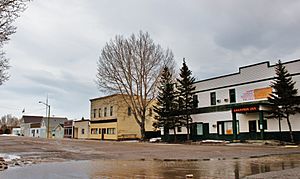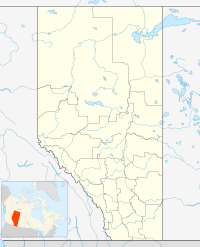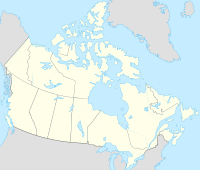Champion, Alberta facts for kids
Quick facts for kids
Champion
|
|
|---|---|
|
Village
|
|
| Village of Champion | |

South side of Main Street Champion 2011
|
|
| Country | Canada |
| Province | Alberta |
| Region | Southern Alberta |
| Census division | 11 |
| Municipal district | Vulcan County |
| Incorporated | |
| • Village | May 27, 1911 |
| Government | |
| • Type | Mayor–council government |
| Area
(2021)
|
|
| • Land | 0.88 km2 (0.34 sq mi) |
| Elevation | 960 m (3,150 ft) |
| Population
(2021)
|
|
| • Total | 351 |
| • Density | 400.7/km2 (1,038/sq mi) |
| Time zone | UTC−7 (MST) |
| • Summer (DST) | UTC−6 (MDT) |
| Forward sortation area |
T0L 0R0
|
| Area code(s) | 403, 587, 825 |
| Highways | Highway 23 |
Champion is a small village located in southern Alberta, Canada. It is part of Vulcan County. You can find it on Highway 23. Champion is about 74 kilometres (46 mi) north of Lethbridge and 147 kilometres (91 mi) south of Calgary.
Contents
Discovering Champion's Past
Early Settlers and the First Businesses
People looking for new homes, called homesteaders, started arriving in the Champion area around 1904 and 1905. Many came from the United States, Eastern Canada, and Britain. The wide-open prairie grasslands, with the Little Bow River flowing through, were perfect for farming and ranching.
One of these early settlers was Martin G. Clever, who arrived in 1905. He settled on a piece of land (160 acres) where the village of Champion stands today.
The Rise of Coal Mining
The village started to grow quickly because more people were settling in the area for farming and ranching. But another big reason was the discovery of coal. In 1906, a homesteader named Henry Therriault opened the first coal mine nearby. Soon, farmers from other towns like Nanton and Stavely traveled to buy coal from his mine.
Their journey often took them through Martin Clever's land. Martin Clever quickly saw a chance to start new businesses.
From Cleverville to Champion
Soon, a country store and a mail delivery service were set up. When the store owner, George Mark, asked for a government post office, the growing settlement needed a name. To honor Martin Clever, it was named Cleverville.
Martin Clever let people use his land for free, which helped many businesses open. Cleverville soon had three general stores, a hat and linen shop, a drug store, a butcher shop, a blacksmith shop, a stable, a restaurant, two real estate offices, a lumber yard, a bank, and a doctor's office.
Moving the Village
In 1910, the Canadian Pacific Railway (CPR) came to the area. However, the railway tracks were not going to pass directly through Cleverville. So, the people of Cleverville decided to move the entire town! They used horses, skids, and wagons to move all the buildings closer to the railway.
This new location needed a new name. The relocated Cleverville became the new Village of Champion. There are a few stories about how Champion got its name. The most popular one says it was named after H.T. Champion, a banker from a well-known firm in Winnipeg. This firm helped many settlers in the west.
Champion Becomes Official
The Village of Champion officially received its charter (like a special permission document) on May 27, 1911. The first village council meeting was held in June of that year.
As the village grew, it needed more services. Champion soon had its first grain elevator (in 1912), a telephone office, a school (in 1913), places for fun activities, and more shops. A local newspaper, The Champion Chronicle, started in 1918 or 1919 and was printed until 1943.
The "Million Bushel Town"
Agriculture (farming) was very important for Champion's growth. In 1915, Champion became known as the "Million Bushel Town." This was because one million bushels of wheat were shipped from the village that year!
The Champion Board of Trade wanted to tell everyone that Champion was a great place for opportunities. In 1913, they published a pamphlet called "Grain Golden Champion". They sent it all over the world to encourage settlers and business people to move to the area.
The pamphlet said Champion was one of the fastest-growing towns in Western Canada. It invited people to come for grain farming, raising chickens and other animals, railway work, making bricks and cement, and developing natural gas and coal resources.
Life in Champion Over Time
Champion's population reached about 650 people at its peak. It grew into a stable and friendly village. Building the Community Hall in the late 1920s was a very important event. This hall still hosts many social events today.
Besides farming, coal mining was also a big part of the local economy. Between 1906 and 1965, there were 58 registered coal mines in the Champion area. Many farmers worked in the mines during the fall and winter when farm work was slow. This helped them earn extra money and provided coal for heating homes.
Farming, however, remained the most important activity. By the mid-1920s, Champion had seven grain elevators. These tall buildings were important landmarks for prairie towns. But as grain handling changed, Champion's wooden grain elevators, like many others, became old-fashioned. The last one was taken down in 2004.
Champion's population has stayed small but active. Sports were a big part of community life, especially the Champion Men's baseball team in the 1950s and 1960s. Clubs like the Lions Club, the Royal Canadian Legion, 4-H clubs, Scouts and Girl Guides, and the Pioneer Club help keep the community strong.
Since it was founded, the Village of Champion has celebrated its anniversary every five years, usually on the July 1st long weekend. In 2011, the village celebrated its 100th anniversary!
Champion's Population
How Many People Live in Champion?
According to the 2021 Census, the Village of Champion had a population of 351 people. These people lived in 164 of the 192 homes in the village. This was a small increase from its 2016 population of 317.
The village covers a land area of 0.88 km2 (0.34 sq mi). This means that in 2021, there were about 398.9/km2 (1,033/sq mi) people living in each square kilometer.
In the 2016 Census, Champion had 317 people living in 164 homes. This was a decrease from its 2011 population of 378. The land area in 2016 was 0.89 km2 (0.34 sq mi).
Services and Fun in Champion
Education and Learning
Champion has two schools:
- The Champion Community School teaches about 70 students from grades 1 to 9. It also has a kindergarten run by parents.
- The Hope Christian School offers classes for grades K-12.
Recreation and Community Life
There are many places for fun and community activities in Champion:
- The Champion Public Library
- An outdoor Community Pool
- The Pioneer Club Seniors' Drop-In Centre for older adults
- Two baseball fields
- The Champion Community Park and Campground
- A Rodeo arena
- The Royal Canadian Legion
- A skating arena with natural ice in the winter
Local Businesses and Shops
Champion has several businesses to serve its residents:
- A restaurant/bar
- A grocery, liquor, and lottery store
- A self-serve gas station
- A thrift store
- A bank
- A post office
- Various other local businesses
Safety and Support
For emergencies, Champion is served by the RCMP (police) and EMS (ambulance) from nearby Vulcan. The village also has its own Champion Volunteer Fire Department.
Places of Worship and Nature
Champion has several churches, including St. Mary's Catholic Church, the Champion Congregational Church, and a local meetinghouse of the Church of Jesus Christ of Latter-day Saints.
Champion is also a great starting point to visit Little Bow Provincial Park. This park is about 15 kilometres (9.3 mi) east of the village. It offers camping and many other outdoor activities.
Famous People from Champion
- Rosella Bjornson - She was the first female airline pilot in Canada and the first female captain in Canadian aviation.
- Jannette Oke - A well-known writer of Christian novels.



